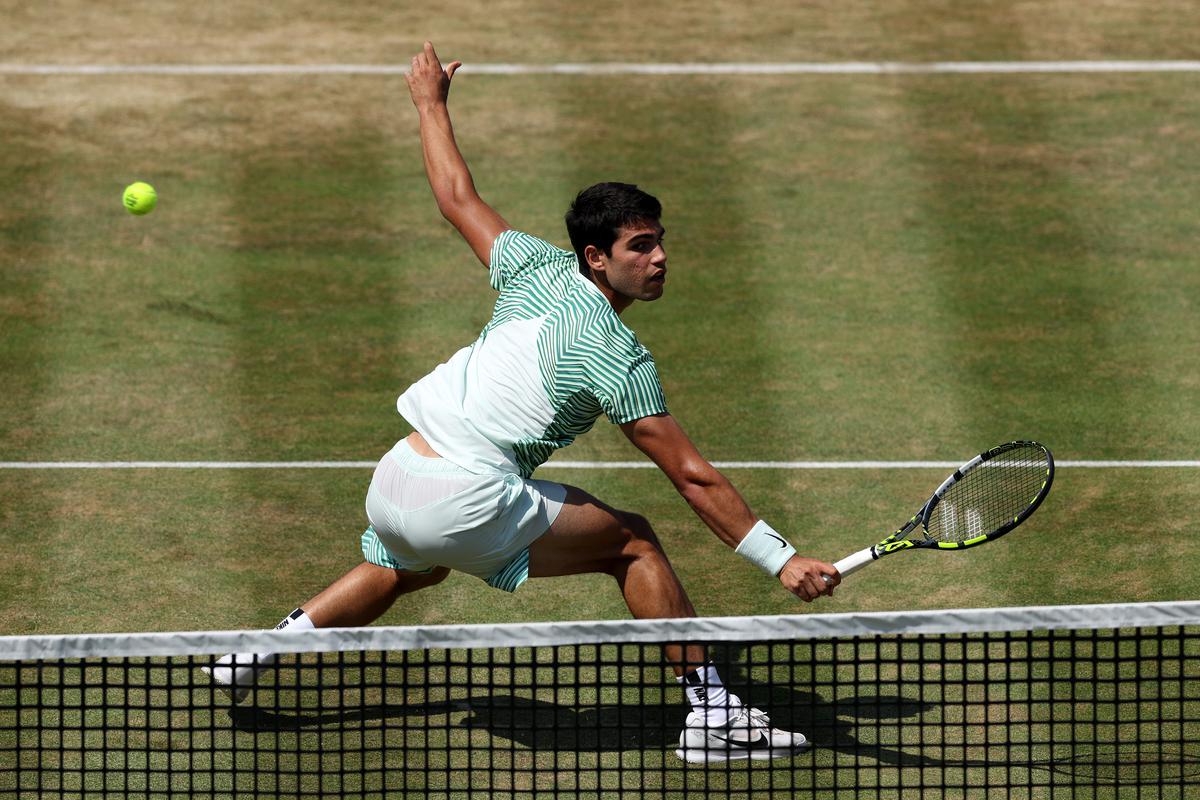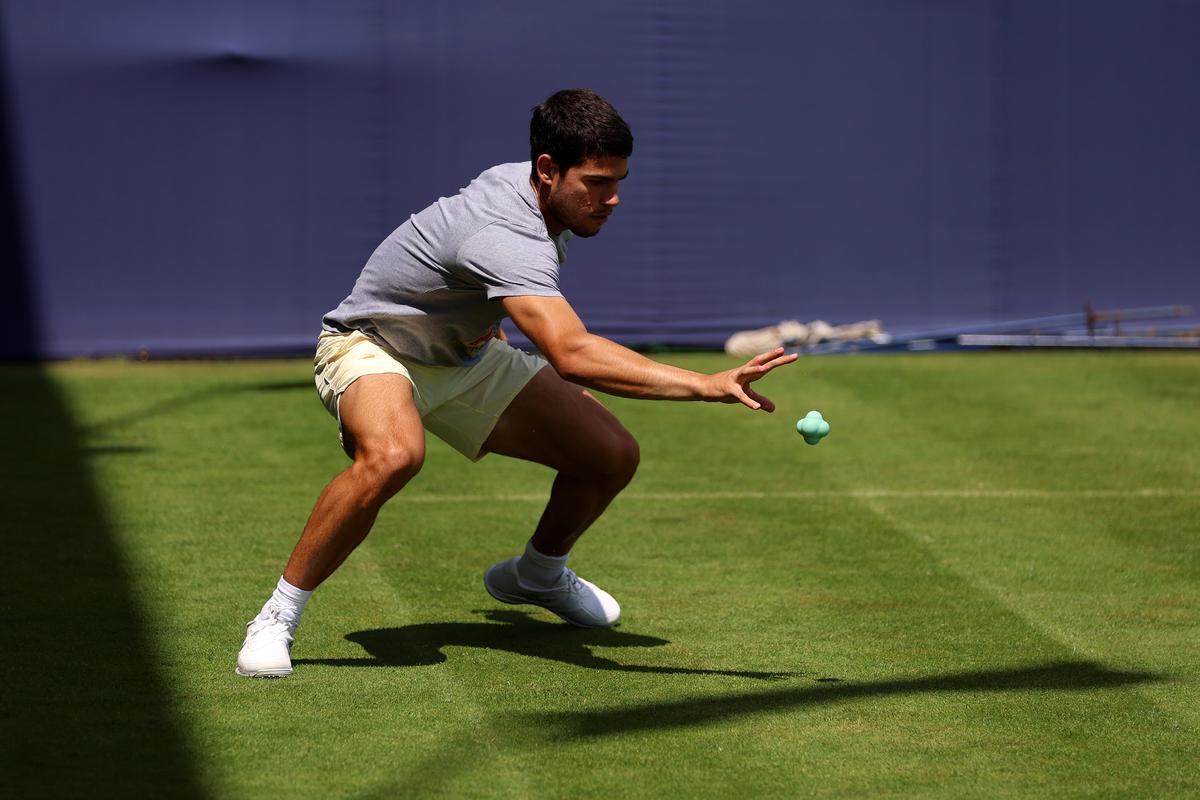Carlos Alcaraz: Is the King of Queen’s a Wimbledon contender?

Not net-shy: At Queen’s Club, Alcaraz showcased qualities that bring success on grass, including a sense of assurance when volleying. | Photo credit: Getty Images

Honing his craft: Aware of how important it is to move well on grass, the Spaniard has worked tirelessly to adapt his footwork to the surface. | Photo credit: Getty Images
Clay-court specialists of a certain vintage had a pet phrase for the period between Roland Garros and Wimbledon, when they were leaving their beloved dirt and attempting to find their feet on the lush lawns.
“Grass is for cows,” they would say, repeating an expression reportedly coined by Spain’s Manuel Santana, who ironically won the Wimbledon men’s singles title in 1966.
It was a line many Spanish players turned to in the 1980s and 90s — and despite Conchita Martinez’s triumph in the women’s singles in 1994, it wasn’t until Rafael Nadal mastered Wimbledon’s Centre Court in 2008 and 2010 that Spanish players began to look at playing on grass as an opportunity and not an obligation.
Garbine Muguruza’s success in 2017 furthered this belief, and so the idea of a Spanish top seed at Wimbledon is no longer unimaginable. Especially after Wimbledon moved from its grass-weighted seeding formula to a system based solely on the rankings.
Carlos Alcaraz, the men’s No. 1 seed at next week’s Championships, isn’t a clay-court specialist by any means, but he is still discovering his game on grass.
Before last week’s Queen’s Club Championships, the 20-year-old had played just six matches on the surface — all of them at the All England Club across two Wimbledon appearances.
Difficult start
Alcaraz’s first grass-court match outside Wimbledon proved challenging. He had to fight back from a set down to beat Arthur Rinderknech, a 6’5” Frenchman ranked in the mid-80s.
In his first appearance since losing to Novak Djokovic in the French Open semifinals, Alcaraz faced difficulties in dealing with Rinderknech’s big serve and net coverage. “I wasn’t able to practise too much at home as we have no grass courts,” he said. “It’s tough playing here but I enjoy playing on grass. I would say I’m going to be better in the next round.”
Alcaraz lived up to his word, growing in confidence on the surface and winning the next four matches without dropping a set to secure the prestigious Queen’s Club title. “It means a lot to have my name on the trophy,” he said. “It was special to play here where so many legends have won. To see my name surrounded by the great champions is amazing.”
Alcaraz will now hope to emulate the men who tasted Wimbledon success after being crowned the King of Queen’s. Over the last 40 years, this list includes Andy Murray (2013, 2016), Nadal (2008), Lleyton Hewitt (2002), Pete Sampras (1995, 1999), Boris Becker (1985) and John McEnroe (1984).
“I have quite a lot of confidence heading into Wimbledon,” said Alcaraz. “I ended the week playing at a high level, so right now I feel [like] one of the favourites to win Wimbledon. I mean, Novak [Djokovic] is the main favourite. That’s obvious. But I will try to play at this level, to have chances to beat him or make the final.”
Djokovic, who chose not to play a grass warm-up event, has reigned supreme in SW19 in each of the past four editions — 2018, 2019, 2021 and 2022; the tournament was cancelled in 2020 because of the coronavirus pandemic. He has won seven Wimbledon titles in all.
Alcaraz knows he will have to improve further on grass to oust Djokovic from his throne. The Serb’s 86 wins at Wimbledon are more than the rest of the top 20 combined. It’s a detail the World No. 1 is aware of. “I saw a statistic that Novak has won more matches in Wimbledon than the other top 20 players [put together],” Alcaraz said. “What can I say about that, you know?”
Centre Court supremacy
Indeed, Djokovic has not lost on Centre Court in 10 years. Given that Alcaraz and Djokovic are the top two seeds, they can meet only in the championship match on July 16. And Alcaraz is hoping to have the crowd on his side should the two keep their date. “I also saw that Djokovic has never lost a match on Centre Court since 2013 when he lost against Andy [Murray], it’s crazy. But I hope to have the crowd behind me to change that stat.”
But while Alcaraz is being seen as the only legitimate threat to Djokovic at Wimbledon, it’s far from certain that the 20-year-old will have a deep run. He made the last 16 in 2022, beaten by Jannik Sinner. Playing as a wildcard in 2021, he lost in the second round to Daniil Medvedev.
Alcaraz has improved since then, but has his grass-court game advanced sufficiently to deal with the threats that lurk on the slippery, naturally wearing surface?
The signs from Queen’s were encouraging. Even 22-time Grand Slam champion Nadal took a while to adapt to grass, but the speed at which Alcaraz looked at ease was astonishing. He faced tricky opposition: 2014 Queen’s winner Grigor Dimitrov in the quarters, the 6’5” Sebastian Korda in the semis and Alex de Minaur, one of the craftiest lawn players around, in the final.
Alcaraz showcased qualities that bring success on grass — notably an impressive sliced backhand when required and confidence around the net. His forehand was often devastating, regularly clocking 90mph and drawing gasps from the crowd. While his second serve offered the opponent an opening — he lost 50% of such points — he did enough with his first serve (66% accuracy, 76% points won) on a surface weighted in the server’s favour.
Emphasis on movement
Most significant of all was his emphasis on movement — it’s accepted tennis wisdom that every facet of play on grass, with its lower, less predictable bounce, flows from footwork.
“Moving, for me, is the key to everything on grass,” Alcaraz said. “I am comfortable going to the net and playing aggressively. For me it is similar to other surfaces with my style. But the movement is totally different, more tiring, more difficult, so you have to be really specific.”
The Spaniard is studying the best to understand their footwork. “I like to put on videos of Federer, of Murray, who move best on grass,” he said. “I try to imitate them a bit. I’m not talking about Djokovic because he slides like [on a] clay court. [That is] not my case, but I try to put similar stuff in my game that Roger and Andy do in the grass.”
Alcaraz is clearly a fast learner. At Queen’s, he joked that he felt like a grass-court veteran. “Right now I feel like I’m playing for 10 years on grass, it’s something crazy for me,” he said. “I didn’t expect to adapt my movement, my game so fast on grass.”
But he also knows that he needs more experience to fully realise his potential on the surface. Irrespective of what he does at this year’s Wimbledon, it’s clear that he has the attitude to succeed on grass. This, allied with his age and undeniable talent, gives Alcaraz everything he needs to crack the Wimbledon code over the next decade.
For all the latest Sports News Click Here
For the latest news and updates, follow us on Google News.
